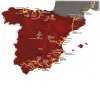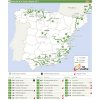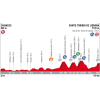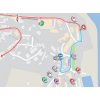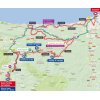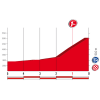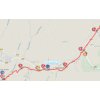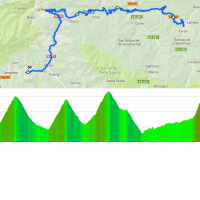Vuelta 2017 Route stage 18: Suances - Santo Toribio de Liébana
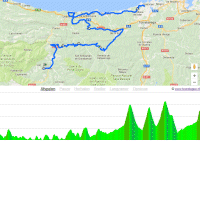
Slideshow 1/16
Thursday, 7 September 2017 - At 169 kilometres, stage 18 in the Vuelta a España runs between Suances and Santo Toribio de Liébana. The route takes in three intermediate ascents in the second half before the race ends with a summit finish after a punchy last climb.
The first 100 kilometres are played out on rolling roads. After this relatively flat opening the route starts to become more hilly. Three back-to-back ascents run to a maximum altitude of 655 metres before the closing climb up Alto de Santo Toribio de Liébana kicks in.
The Collada de Carmona is the first proper climb, crested with 109.5 kilometres done. It’s a 4.8 kilometres ascent at 7.3% with a steepest section of 10% halfway up the slopes.
Following the descent the Collada de Ozalba brings 6 kilometres at 6.5% to the table. Steep ramps? Not really. It’s a very regular climb that flattens out before the top.
Collada de la Hoz is the next challenge. At 6.7 kilometres this is the longest climb of the day, although it’s not the steepest with an average gradient of 5.8%. Yet don’t underestimate the Collada de la Hoz. In the 2012 Vuelta Contador attacked at the these very slopes and outgunned his rivals Alejandro Valverde, Joaquim Rodríguez and Chris Froome, thus laying the groundwork for his eventual overall win that edition. The Collada de la Hoz is crested with almost 30 kilometres remaining.
Following the descent of the Collada de la Hoz a prolonged false flat runs to the foot of the punchy last climb. The Santo Toribio de Liébana is a unprecedented ascent in Vuelta. The line is near a monastery where, rumour has it, the monks treasure a piece of wood of Jesus’ cross. The finale is a 2.2 kilometres slope at 9.3%.
The first three riders on the line take time bonuses of 10, 6 and 4 seconds, while the intermediate sprint (at kilometre 132.7) comes with 3, 2 and 1 seconds.
Read also: results/race report 18th stage 2017 Vuelta.
Vuelta 2017 stage 18: Route maps, height profiles, and more
Click on the images to zoom
+ Click for more images (12)
Watch the highlights of recent races here:
Related articles The Route - Vuelta 2017 Riders - Vuelta 2017 Withdrawals - Vuelta 2017 Route and stages - Vuelta 2017 Start times time trial - Vuelta 2017 GC Favourites - Vuelta 2017 More articles Giro 2025: Live report stage 3
Giro 2025 Route stage 3: Valona – Valona
Giro 2025 Favourites stage 3: Breakaway day
Giro 2025: Withdrawals
Giro 2025: The Route
Giro 2025: Riders
Giro 2025: GC Favourites
Giro 2025 Route stage 4: Alberobello – Lecce
Giro 2025 Favourites stage 4: For fast men #1
Giro 2025 Route stage 5: Ceglie Messapica - Matera
Giro 2025 Favourites stage 5: For fast men #2
Giro 2025 Route stage 6: Potenza - Naples
Giro 2025 Favourites stage 6: Hilly race with flat finale
Giro 2025 Route stage 7: Castel di Sangro - Tagliacozzo
Giro 2025 Favourites stage 7: First mountain top finish
Giro 2025 Route stage 8: Giulianova – Castelraimondo
Giro 2025 Favourites stage 8: Attackers in the Apennines
Giro 2025 Route stage 9: Gubbio - Siena
Giro 2025 Favourites stage 9: Strade Bianche alla Giro
Giro 2025 Favourites stage 10: For pure time trialists
Giro 2025 Route stage 11: Viareggio – Castelnovo ne’ Mont
Giro 2025 Favourites stage 11: Attackers in promising finale
Giro 2025 Route stage 10: Lucca – Pisa
Vuelta Femenina 2025 Route stage 6: Becerril de Campos - Baltanás
Cycling Calendar 2025
Tour de France 2025: The Route
Tour de France 2025 Route stage 1: Lille - Lille
Tour de France 2025 Route stage 2: Lauwin-Planque - Boulogne-sur-Mer
Tour de France 2025 Route stage 3: Valenciennes - Dunkirk

